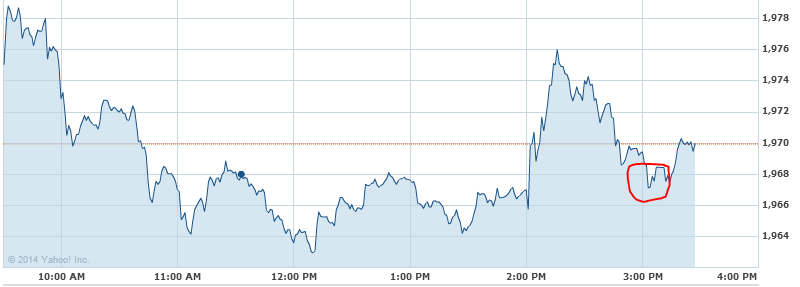The U.S. Federal Reserve stuck to its usual script today after the Federal Open Market Committee (FOMC) meeting. The Fed announced the expected $10 billion cut to its almost two-year-old bond-buying program and reaffirmed its intention to keep interest rates low for a "considerable" period of time.
 |
| Click to Enlarge |
Strangely enough, the news of unexpected and optimistic growth figures for the U.S. economy released this morning wasn't enough to move the markets, as the S&P 500 was down as much as 7.53 points before the FOMC release, but the Fed's predictable comments did trigger activity. The S&P 500 advanced 4.56 points just half an hour after the 2 p.m. EDT release.
"The actual numbers are just the latest figures to come out and we always know there's that next round of numbers," said Clifford Rossi, executive-in-residence and professor of the practice at the University of Maryland's Robert H. Smith School of Business. "The Fed is taking this big picture, long-term view."
He added that, typically, Fed comments will "trump the day's news unless there's something really, truly extraordinary" coming out of economic data releases.
The Fed has been tapering its bond-buying program, known as the third round of quantitative easing (QE3), by $10 billion with each FOMC meeting since December 2013, and this latest round of cuts sets the current pace of asset purchases at $25 billion a month. As the minutes from June's meeting suggest, QE3 will end in October with one final $15 billion reduction.
That will end a massive stimulus program that began in September 2012 under former Fed Chairman Ben Bernanke, aimed to help hold down long-term interest rates and kick-start a slowly growing economy. It began as a monthly purchase of $40 billion in agency mortgage-backed securities (MBS) and another $45 billion in long-term Treasurys, bringing the monthly asset purchase total to $85 billion. In its December 2013 meeting, the FOMC announced its intention to begin reducing these purchases by $5 billion for both the MBS and the Treasury securities, for a total of $10 billion in reductions.
Despite the Fed making the time frame for its easing policy more clear, it didn't offer the same clarity on interest rates...
FOMC Meeting Still Ignores Interest Rates
Yellen has maintained that the Fed funds target rate of 0% to 0.25% will stay in effect for a "considerable" period, or at least until the labor market conditions are conducive to a rise in interest rates.
Many expect interest rates to rise sometime in the second half of 2015, though in a press conference following the March meeting, Yellen said that interest rates could rise as soon as six months after the end of the taper. This pushed the timeline forward for interest rate increases to as early as spring 2015, spooking investors and sending the S&P 500 down 0.61% on the day.
Rossi said he would be surprised if the Fed raises interest rates before the second quarter of 2015. He said there is still slack in the labor market and the "housing market has yet to take off in a major way, still five years after the crisis," which will heavily weigh on the mind of a labor economist and policy dove like Yellen.
Yellen has since tempered her rhetoric on the interest rate picture and instead continues to stay vague on a timeline. The Fed's current refrain on interest rates is that they will remain low until the economy has seen substantial improvement.
While Yellen will likely not present a bold statement for interest rate hikes, even after the taper ends, Rossi said a forthcoming rate hike will be articulated more through a softening of rhetoric or a change in tone rather than an explicit statement because "the Fed wants to tread lightly on this," and not risk scaring the markets.
As it stands, the national unemployment rate is at 6.1% with new numbers coming out this Friday. Additionally, new economic growth figures released today have the economy roaring ahead at a 4% annual pace, better than what was expected after last quarter's 2.1% contraction.
Trading on FOMC Meeting Days
After the FOMC statement was released, the Dow Jones Industrial Average gained as much as 111.3 points from its lows earlier on in the day, though still down in the afternoon from its 16,920.11 open. Similarly, the S&P was up as much as 13.59 points from its lows earlier in the day.
Since the Fed cut interest rates under Bernanke to their near-zero level in December 2008, the S&P 500 has averaged a 0.48% gain on FOMC meeting days, according to a report by BeSpoke Investment Group LLC.
In the most recent two-day meeting ending on June 19, the S&P surged ahead 0.77%. That increase pales in comparison to the 1.66% boost it got in December 2013 when Bernanke first announced the start of the taper. The average gain in the S&P on Fed meeting days since then has been 0.22%.
The Fed has been quiet on when there will be the inevitable rise in interest rates, and while it may be commonly held wisdom that stock markets falter on rate hikes, there are three companies that stand to gain from such a scenario...


